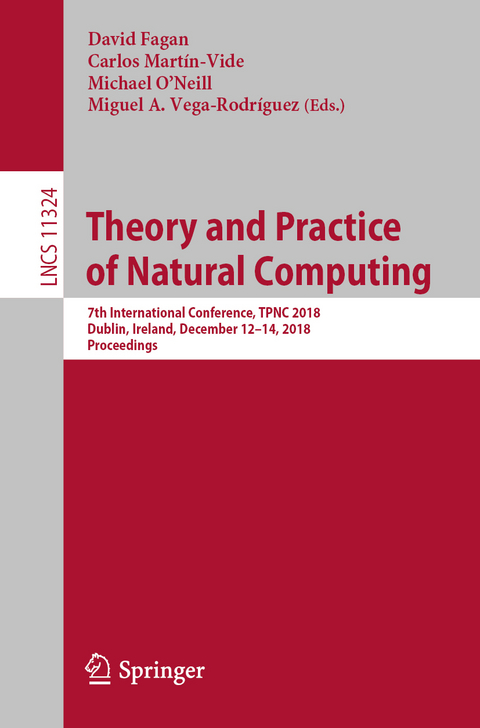
Theory and Practice of Natural Computing
Springer International Publishing (Verlag)
978-3-030-04069-7 (ISBN)
This book constitutes the refereed proceedings of the 7th International Conference on Theory and Practice of Natural Computing, TPNC 2017, held in Dublin, Ireland, in December 2018. The 35 full papers presented in this book, together with one invited talk, were carefully reviewed and selected from 69 submissions. The papers are organized around the following topical sections: applications of natural computing as algorithms, bioinformatics, control, cryptography, design, economics. The more theoretical contributions handle with artificial chemistry, artificial immune systems, artificial life, cellular automata, cognitive computing, cognitive engineering, cognitive robotics, collective behaviour, complex systems, computational intelligence, computational social science, computing with words, developmental systems, DNA computing, DNA nanotechnology, evolutionary algorithms, evolutionary computing, evolutionary game theory, fractal geometry, fuzzy control, fuzzy logic, fuzzy sets,fuzzy systems, genetic algorithms, genetic programming, granular computing, heuristics, intelligent agents, intelligent systems, machine intelligence, molecular programming, neural computing, neural networks, quantum communication, quantum computing, rough sets, self-assembly.
Explainable AI and Fuzzy Logic Systems.- Computing Preimages and Ancestors in Reaction Systems.- Poisson Equation Solution and Its Gradient Vector Field to Geometric Features Detection.- Self-organised Aggregation in Swarms of Robots with Informed Robots.- Spatial Types: a Scheme for Specifying Complex Cellular Automata to Explore Artificial Physics.- Application of STRIM to Datasets Generated by Partial Correspondence Hypothesis.- Multi-party Computation Based on Physical Coins.- Patterns and Their Interaction in Excitable Media on Face-centered Cubic Lattice.- Graph Minors from Simulated Annealing for Annealing Machines with Sparse Connectivity.- Gaussian-kernel c-means Clustering Algorithms.- A Linear Constrained Optimization Benchmark for Probabilistic Search Algorithms: the Rotated Klee-Minty Problem.- The Design of (Almost) Disjuct Matrices by Evolutionary Algorithms.- Landscape-aware Constraint Handling Applied to Differential Evolution.- Fuel Efficient Truck Platooning withTime Restrictions and Multiple Speeds Solved by a Particle Swarm Optimisation.- Automated Design of Genetic Programming Classification Algorithms for Financial Forecasting Using Evolutionary Algorithms.- Optimizing Fleet Staging of Air Ambulances in the Province of Ontario.- A Hierarchical Approach to Grammar-guided Genetic Programming: the Case of Scheduling in Heterogeneous Networks.- Multi-memetic Mind Evolutionary Computation Algorithm Based on the Landscape Analysis.- DNA-guided Assembly of Nanocellulose Meshes.- Classically Time-controlled Quantum Automata.- Mortal Organisms Rescue Immortal Organisms from Evolutionary Inertness: Perspective of the Programmed Self-decomposition Model.- Integrative Biological, Cognitive and Affective Modeling of a Drug-therapy for a Post-traumatic Stress Disorder.- Symbolic Analysis of Machine Behaviour and the Emergence of the Machine Language.- It Is Time to Dissolve Old Dichotomies in order to Grasp the Whole Picture of Cognition.- Network-oriented Modeling of the Interaction of Adaptive Joint Decision Making, Bonding and Mirroring.- Network Reification as a Unified Approach to Represent Network Adaptation Principles within a Network.- Relating an Adaptive Network's Structure to Its Emerging Behaviour for Hebbian Learning.- On Capacity with Incremental Learning by Simplified Chaotic Neural Network.- Tighter Guarantees for the Compressive Multi-layer Perceptron.- Information-theoretic Self-compression of Multi-layered Neural Networks.- Radial Basis Function Networks Simulation of Age-structure Population.- Bio-inspired Spiking Neural Networks for Facial Expression Recognition: Generalisation Investigation.- Novel Ensembling Methods for Dermatological Image Classification.- SemVec: Semantic Features Word Vectors Based Deep Learning for Improved Text Classification.- Three Analog Neurons Are Turing Universal.
| Erscheinungsdatum | 24.11.2018 |
|---|---|
| Reihe/Serie | Lecture Notes in Computer Science | Theoretical Computer Science and General Issues |
| Zusatzinfo | XII, 474 p. 155 illus., 100 illus. in color. |
| Verlagsort | Cham |
| Sprache | englisch |
| Maße | 155 x 235 mm |
| Gewicht | 741 g |
| Themenwelt | Mathematik / Informatik ► Informatik ► Netzwerke |
| Informatik ► Theorie / Studium ► Algorithmen | |
| Informatik ► Theorie / Studium ► Künstliche Intelligenz / Robotik | |
| Mathematik / Informatik ► Mathematik ► Wahrscheinlichkeit / Kombinatorik | |
| Schlagworte | Algorithm Analysis • Applications • Artificial Intelligence • artificial intelligence (incl. robotics) • authentication • bio-inspired optimization • computation by abstract devices • Computer Communication Networks • Computer Science • conference proceedings • Decision Support Systems • evolutionary algorithms • Genetic algorithms • Informatics • information systems applications (incl. internet) • machine learning • Mathematical Optimization • molecular computing • Neural networks • Petri Nets • problem complexity • Problem Solving • Quantum Computing • Research • Software engineering |
| ISBN-10 | 3-030-04069-0 / 3030040690 |
| ISBN-13 | 978-3-030-04069-7 / 9783030040697 |
| Zustand | Neuware |
| Haben Sie eine Frage zum Produkt? |
aus dem Bereich


